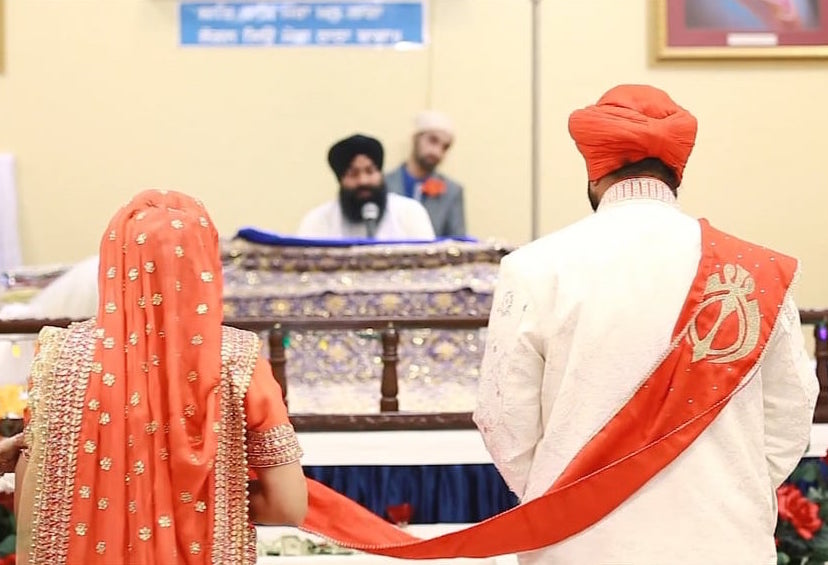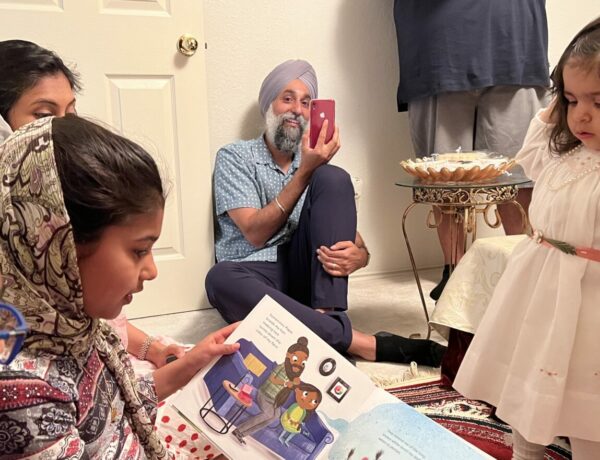Dr. Jaspreet Kaur and Santbir Singh uncover the parallels between Sikh oppression in Punjab, and Indigenous subjection on Turtle Island (currently North America). They highlight how women have been central in the struggle for land, water, and self-determination, and make a strong case for Sikhs supporting and standing in solidarity with Indigenous movements.
In April of 2016, young women from the Standing Rock Sioux Tribe brought attention to an issue that would change the world. Thirteen-year-old girls Tokata Iron Eyes and her friend Anna Lee Rain Yellowhammer, along with their friends, started a petition, a hashtag, held rallies, and organized a 2000 mile relay race to Washington D.C. to deliver their petition.
What came to be known as the #NoDAPL movement garnered international attention and is still being battled. The issue of water and land because tied to identity, the right to exist and environmental rights.
Almost a hundred year earlier, another young woman similarly stood up for her land in a move that would shape Sikh history and activism. In 1914 the British were designing New Delhi, their new capital for an empire that was to stand for a thousand years. Gurduara Rakab Ganj, where Guru Teghbahadur Sahib’s body had been so lovingly cremated, stood in the way of their carefully laid out roads. As the colonialists knocked down the wall of the Defender of Freedom, who had so boldly sacrificed his life for principle of freedom of choice, one solitary woman stood before the might of the world’s most powerful empire. Young Bibi Sham Kaur, a widow, lay down before the machines, her baby clutched to her chest. The British were astounded and the Sikh nation was awoken from a decades long slumber. The Gurduara Reform Movement was launched and it fed directly into the Independence Movement, which grew into Punjabi Suba Struggle and finally the Dharm Yudh Morcha and the struggle for Sikh Sovereignty.
Land and water have been a part of the Sikh identity from the inception of the faith. Guru Nanak Sahib writes in Asa ki Var (SGGS Ang 472) that water is the root of all life; it gives birth to all living things, including our very Panth. From Guru Nanak Sahib’s emergence from the waters at Sultanpur Lodhi to the creation of the Khalsa with the Gurbani, Patasa and Khanda infused Amrit of Guru Gobind Singh Sahib, water is the transformative medium through which a connection with Vahiguru is facilitated. We are a people spiritually born from water, who are replenished by Sarovars and Baoilis, and who come from Punjab, a land of grain, plentiful resources and of course water; Punjab literally meaning the Land of Five Rivers. To understand Punjab and its tumultuous history, you have to understand the water; it is connected to the rhythms of life, rights of religious passage, and the fight for Sikh sovereignty. Everything in Punjab can be traced back to it.
Over the last seventy years Sikhs, and in truth Punjabis of all backgrounds, have been victimized time and time again by the Indian government. The importance of water in Punjab was never beyond the understanding of the central government of India. The diversion of water out of Punjab and into neighbouring states occurred as a part of the Punjab Reorganization Act under Indira Gandhi’s government, are law that was part of the long term strategy of the Indian state to attack Sikhs at a number of levels, from undermining our religious institutions, destroying Punjabi culture and language, taking away our economic resources and removing entire parts of the Punjabi speaking homeland (already fractured from the 1947 Partition) from us. But more than anything it was the loss of control of our own rivers and environmental ecosystems was a blow so deep that even now, after fifty years, the wound is still raw to the Punjabi soul.
After decades of peaceful protests the Sikh nation created the Anandpur Sahib Resolution (ASR), an incredible consensus-based document that reached back to the core principles of Sikhi. Though it was labeled as a radical document by the Indian state and media, it would have given Punjab far fewer powers than Quebec enjoys today in Canada, or that any state in the US has or than the rights devolved to Scotland, Wales and Northern Ireland in the UK. What the ASR simply demanded was a democratic and equitable model of reorganization for India, where the rights of minorities (religious, cultural and linguistic) were protected and the Central government’s powers were partly decentralized to the states (in fields like education, resource development, etc). And of course, for Punjab to have control of it’s beloved rivers once more.
As the Panth had done since Bibi Sham Kaur so boldly blocked the British from their illegal takeover of sovereign Sikh land, a non-violent protest movement, the Dharam Yudh Morcha, was organized to push for the implementation of the ASR. The Indian state met these protests with increasingly horrific incidences of violence including of the massacres of innocent protesters (Amritsar Vasakhi Massacre of 1978, Kanpur Massacre of September 1978, Chando Kalan Massacre of 1981) , extrajudicial killings, organized sexual violence against Sikh women and girls and acts of unspeakable sacrilege against Guru Granth Sahib ji and Gurduaras. The trend of targeting Sikh women with state organized rape and sexual assault would only worsen with time, with Kaurs targeted during the November 1984 Pogroms and on an an almost unimaginable scale during the Punjab Police’s counter-insurgency abuses from 1986 to the early 1990s.
At this time of rising discrimination, a great leader of the Panth arose, Sant Jarnail Singh. It was to counter his fight for the implementation of the Anandpur Sahib Resolution, a demand for democratic rights, decentralization and rights over water, that the Government brutally attacked the heart of the Sikh nation in June 1984. And in the decade of genocide that followed the massacre of 10,000 Sikhs on the marble parkarma of Harmandir Sahib, the fight for water rights became intertwined with the struggle for Sikh sovereignty, as the Sikh nation realized it had no choice but to fight for it’s survival.
This should sound familiar. After centuries of oppression, which included everything from forced relocation, organized cultural and linguistic destruction, the stealing and systematic sexual assault of children, exploitation of resources and outright genocide, today Indigenous North Americans face issues like the Dakota Access Pipeline, the recently approved Canadian Kinder Morgan pipeline and the replacement of Enbridge’s Line 3, all of which threaten access to clean drinking water and will potentially compromise traditional hunting and fishing rights.
Beyond pipelines, First Nations across Canada have faced living conditions for decades that settler Canadians wouldn’t bear for even a few hours. As of November 2016, 130 First Nations were living under a boiling water advisory. (A boil-water advisory is a public health advisory given when a community’s drinking water is contaminated by pathogens, and must be boiled to increase its safety.) Everything from cooking, washing and drinking takes more thought than any of us in Canada’s cities would ever consider. While other Nations suffer the ill effects of industry on their sources of water, with decades of government promises constantly remaining broken.
The reasons that many of us in the Sikh diaspora are on the lands of Indigenous people vary, from seeking economic gain and education, to searching for freedom from an oppressive regime. We have settled into the fabric of these countries. We are educators, business people, politicians and artists. And now that we have established ourselves, we have used our social capital to talk about the violence we experienced and stressed the need for our new governments to ally with us against the Indian state in our struggle. And yet, what was once understandable ignorance has now become willful blindness. This was not unclaimed land, waiting for Sikh pioneers to come and tame. This was not an empty country filled with golden opportunity. This was the home of hundreds of nations, with histories that reach so far back in time, the Sikh Panth is but a child in comparison. And our success here, whether we realized it or not, came because others lost what we have been struggling for.
To demand sovereignty as Sikhs while continuing to deny the sovereignty of the people whose land we flourish on is an ongoing act of violence and hypocrisy that stands counter to all Sikh principles. And the irony of a people who are spiritually tied to water, who have such a deep connection to our rivers, and whose loss of control of those rivers has been one of the primary tools of our oppression to not see how integral a role water plays, spiritually and practically, for First Nations, and how any threats or encroachment on that water is unacceptable, is truly mind boggling.
To our Indigenous brothers and sisters of Turtle Island – please know that, like all peoples, Sikhs are a complicated and diverse nation. There is no one Sikh view on anything. Some of us are removed from our principles and traditions so much so that despite the oppression we have suffered we are complicit in your oppression. However, there are also those of us who are trying to remember where we came from. We remember the way our parents and grandparents fought from inside and outside of Punjab to have our humanity validated and our water preserved. We acknowledge that while your battles are unique and that we can never fully understand them, we see ourselves in your fight. We stand with you and ask, what can we do to help? We hear you when you tell us what you need.
To my Sikh brothers and sisters – the world watched in silence as the Indian government took our land, water, resources and, eventually, our lives. Do not stand in silence as it happens to those whose land we live on. Follow the path of Guru Teghbahadur Sahib ji, who showed us that even when it was inconvenient, even when it seemed hopeless and pointless, a Sikh must always stand with the marginalized, a Sikh must always be on the side of freedom and justice. Acknowledge the messy reality of how we benefit from the genocide of Indigenous peoples. Be critical of your complicity and participation. Realize that your economic and political choices have a dramatic impact on these grand, proud and powerful Nations. Relish the freedom of living in a country where you can criticize your government and not pay with your life. Demand explanations from those who are silent. Above all, listen to the many complex voices of Indigenous people and learn to follow what they ask of us. We are but guests in their land.
Water is life. Control of water is sovereignty. And sovereignty is the right of all Nations.
By Dr Jaspreet Kaur and Santbir Singh
Photo by Geetanjal Khanna
Dr. Jaspreet Kaur Bal
 Dr. Jaspreet Kaur Bal is a Professor in the Child and Youth Care program at Humber College in Toronto. She completed her PhD in Cultural Studies from Queen’s University in Kingston Ontario, where she focused on children’s rights, education, and returned for fieldwork to her village in Punjab. Bal serves on the Board of Directors of the Sikh Feminist Research Institute and Kaurs United International.
Dr. Jaspreet Kaur Bal is a Professor in the Child and Youth Care program at Humber College in Toronto. She completed her PhD in Cultural Studies from Queen’s University in Kingston Ontario, where she focused on children’s rights, education, and returned for fieldwork to her village in Punjab. Bal serves on the Board of Directors of the Sikh Feminist Research Institute and Kaurs United International.
Santbir Singh
 Santbir Singh is an avid student of Sikhi, both its philosphy and history. He has taught and spoken at retreats, conferences and youth camps for almost two decades. Santbir focuses on Guru Granth Sahib ji as an inspiration for social activism, feminism, politics and human rights. He tries to reach a critical analysis of Sikhi from a variety of different schools of thoughts and traditions. Born in Vancouver, he holds a Bachelor’s degree from McGill and currently lives in Toronto with his two wonderful children and his crazy dog.
Santbir Singh is an avid student of Sikhi, both its philosphy and history. He has taught and spoken at retreats, conferences and youth camps for almost two decades. Santbir focuses on Guru Granth Sahib ji as an inspiration for social activism, feminism, politics and human rights. He tries to reach a critical analysis of Sikhi from a variety of different schools of thoughts and traditions. Born in Vancouver, he holds a Bachelor’s degree from McGill and currently lives in Toronto with his two wonderful children and his crazy dog.





5 Comments
Rajinder
05/03/2017 at 9:11 pmCould the authors elaborate on ” Young Bibi Sham Kaur, a widow, lay down before the machines, her baby clutched to her chest. The British were astounded and the Sikh nation was awoken from a decades long slumber. The Gurduara Reform Movement was launched and it fed directly into the Independence Movement”
I am not aware of any historical connection between Bibi Sham Kaur and the Gurdwara reform movement
santbir singh
05/03/2017 at 10:19 pmThe information on Bibi Sham Kaur’s dramatic act can be found in Dr. Sangat Singh’s book/doctoral dissertation called: “Freedom movement in Delhi, 1858-1919”. The first chapter which describes Bibi Sham Kaur’s actions is available here: http://www.sikhinstitute.org/gurd_legi/ch_9.htm
Unfortunately, the role that Sikh women have played in our history is often forgotten, marginalized or ignored. Thus an amazing, inspiring and epic event like Bibi Sham Kaur’s defiance against the British is largely unknown today.
Deep Hundal
05/04/2017 at 10:56 pmWhy is Bhai Fauja Singh and the Singhs that led the Dharam Yudh Morcha being considered “Non-Violent?” Are we misrepresenting and reimagining this history here?
The Morcha was not non-violent. The Singhs fought.
santbir singh
05/05/2017 at 12:46 pmWe are a warrior Panth and we should never be ashamed of that heritage, nor fail to live up to the standards of being warriors today. So I apologize if it appears that the article whitewashes that aspect of our Nation.
Here is some clarification of where we’re coming from:
As Guru Teghbahadur Sahib taught us in the most dramatic fashion ( pauris 12 to 16 of Bachitar Natak: https://www.searchgurbani.com/dasam_granth/page/131/line/9 ), and Guru Gobind Singh Sahib told us in Zafarnama ( pauri 22: http://www.zafarnama.com/Download/zafarnama.pdf ), we must exhaust all non-violent means before we pick up the sword.
The 1978 Baisakhi protest against the Nirankaris was:
1. Unrelated to the the Dharm Yudh Morcha. It was organized by the great Panthic leader, Shahid Bhai Fauja Singh and was attended mainly by members of the Akhand Kirtan Jatha along with members of the Damdami Taksal (Baba Jarnail Singh branch).
2. A non-violent protest. The Nirankaris opened fire on the protesting Sikhs, who were (besides their Kirpans of course) unarmed. All sources will confirm this ( https://www.allaboutsikhs.com/historical-events/kurbanithe-life-and-martyrdom-of-shaheed-bhai-fauja-singh-ji ). Bhai Fauja Singh and the protestors did not have guns and did not fight back. They were peacefully protesting to demonstrate how the Panth was being treated at that time. Bhai Fauja Singh knew well that he was likely to be Shahid and had prepared himself spiritually and mentally for many years before the massacre.
Concerning the Dharm Yudh Morcha. The Anandpur Sahib Resolution was finalized and endorsed by the three heads of the Shiromani Akali Dal in 1978: Jagdev Singh Talvandi, president of the SAD, Gurcharan Singh Tohra, president of the SGPC, and Parkash Singh Badal, Chief Minister of Punjab ( https://www.thesikhencyclopedia.com/the-modern-history-of-sikhs-1947-present/anandpur-sahib-resolution ).
Harcharan Singh Longowal had already been the designated leader (dictator was the title used), as chosen by the SAD leadership, of Morchas against the government during Indira Gandhi’s “Emergency”, from 1975 to 1977 ( https://en.wikipedia.org/wiki/Harcharan_Singh_Longowal ).
In 1980 he was asked by the SAD to restart Morchas against the Government for the purpose of the Anandpur Sahib Resolution being achieved. In 1981 he formally started the Dharm Yudh Morcha ( http://www.panjabdigilib.org/webuser/searches/displayPage.jsp?ID=8902&page=1&CategoryID=1&Searched= ) .
The Morcha was not as successful as previous ones as the Panth had become disillusioned and cynical with all the cynical games played by the Akali Dal leadership since the days of Sant Fateh Singh and the Punjabi Suba Morchas.
In 1981 Shahid Baba Jarnail Singh was arrested on false charge for the murder of the fascist Hindutva newspaper publisher Lala Jagat Narain (think Breitbart of Punjab but much worse) at Chando Kalan ( Section 3, Part B: http://www.panthic.org/articles/2519 ) and not only were 20 innocent Sikhs were massacred but two buses belonging to the Bhindranwale Taksal, which had gutkas, sainchees and even Guru Granth Sahib sarups were burned by the Haryana Police ( https://i2.wp.com/khalsaforce.in/wp-content/uploads/2015/09/13256820_271906796530413_573290599_n.jpg ). This horrific sacrilege prompted Baba Jarnail Singh to start his own protest movement. In 1982, his two closest advisors, Baba Thara Singh and Bhai Amrik Singh (President All India Sikh Student’s Federation) were arrested on false charges by the government.
The arrest of these two close advisors led to an increase in the protest movement that Baba Jarnail Singh started. In July of 1982, in attempt to coopt the popularity of Baba Jarnail Singh’s movement, Harcharan Singh Longowal invited Baba Jarnail Singh to stay at the Darbar Sahib Complex, as has been Panthic tradition for Morcha leaders since 1920. A month later, Longowal formally started the Dharam Yudh Morcha and Baba Jarnail Singh joined this larger Panthic movement ( https://www.thoughtco.com/sant-harchand-singh-longowal-2992908 ).
The Morcha itself was a peaceful movement and was modelled on the strategy the community had been using since the Gurduara Reform Movement of the early 20th century.
However, the government as well as Hindu Nationalists began to target innocent Sikhs, with organized attacks, sexual violence and sacrilege against Gurduaras and Guru Granth Sahib ji ( Section 3: http://www.panthic.org/articles/2519 )
As the Akali Dal refused to act in accordance with Gurmat tradition, Baba Jarnail Singh took on the role of Defender of the Nation. It is a Sikh obligation to defend oneself against murderous and violent acts. And if the government is either responsible or incompetent, then justice must be carried out. This is when Baba Jarnail Singh created the “Motorcycle Vale”, who were young Sikhs tasked with punishing those who were killing and attacking innocent Sikhs and sending a message that the Khalsa Panth will stand up for itself. Led by great Sikh warriors like Shahid Bhai Surinder Singh ‘Sodhi’ and Shahid Bhai Manvir Singh ‘Chaheru’, these guerilla fighters brought respect and dignity back to the community and more importantly, demonstrated that while we are a peaceful people, we will not just allow ourselves to be massacred without response.
I hope that clears up any confusion.
Brian Dickie
11/28/2022 at 11:17 pmThank you for the education.